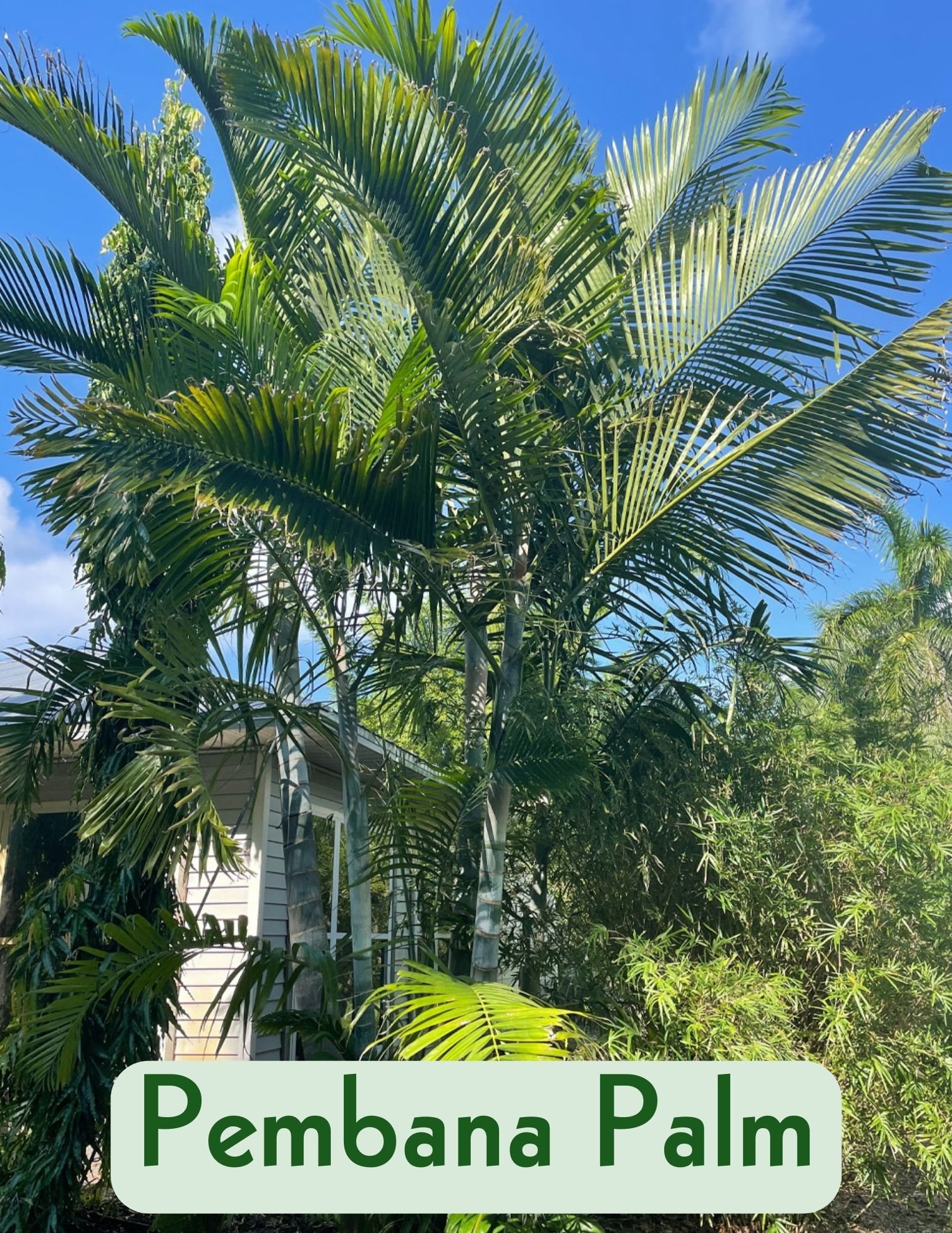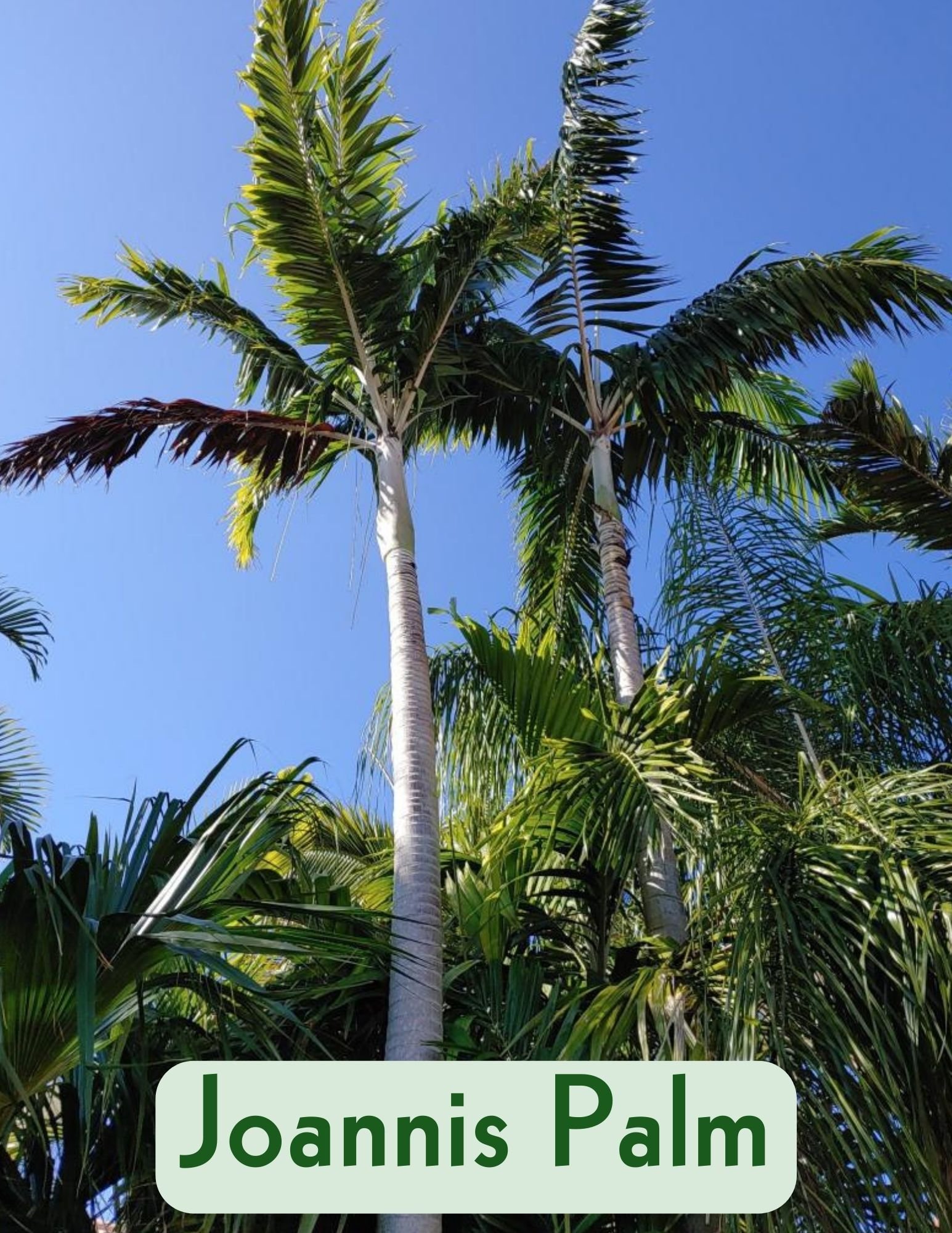Broaden your Horizons with Palms
It’s hard not to admire the variety of palms growing here on our beautiful island. So many amazing species with many unique fronds, shapes, and colors. When it comes to palms, there seems to be a handful that everyone comes in looking for, landscapers and homeowners alike. And because of the high demand, we don’t always have the popular choice in stock. Landscape Designers tend to recommend and use the same palms in their designs because they know them well and know they will look good in the landscape. But there are always alternatives to these popular picks, some you may not have even known existed! So don’t limit yourself, let’s look into the most highly requested palms, and explore some equally exceptional choices for your landscape.
Broaden your horizons with palms!
Want the…
Cyrtostachys renda
Popularly known as the Lipstick Palm, the Sealing Wax Palm is a slow-growing, highly coveted landscape palm.
The name originates from the bright red stalks and fronds that mimic the color of wax used to seal letters.
This palm is extremely rare and is considered exotic. It takes years for the palm to reach its mature size and can be difficult to care for.
It is definitely a “Collector’s Palm” and is a prized specimen in many landscapes.
Sealing Wax Palm can reach 40-50 feet once mature. The seeds take a long time to germinate. Once a seedling is established, the palms require full sun, high humidity, well-draining soil, and frequent watering.
Sealing Wax Palms are not drought or wind-tolerant, making them a difficult plant to grow in coastal areas and drier climates.
Now here’s the kicker: Because of their slow growth and difficult cultivation, Sealing Wax Palms retail for over 3x the price of other standard palms. Not everyone has a Sealing Wax Palm budget, but luckily for you, we have an alternative.
Try the…
Areca vestiaria
If you love the look of the Lipstick Palm but can’t get past the price, consider the Orange Crownshaft Palm!
This palm has similar growth habits to the Sealing Wax. Its unique coloration in the crownshaft mimics the look of the Sealing Wax but with a more orange hue.
Similar to the Lipstick Palm, it puts out keikis at the base and can clump together, but you could also train it to grow as a solitary palm.
The Orange Crownshaft Palm does best in an area with part shade and low wind exposure.
It is still considered a slow-growing palm, but grows much faster than the Lipstick Palm. The mature height reaches 20-25 feet.
If you’re looking for a specimen palm to be the focal point of your landscape but don’t want to pay the specimen plant price, consider the beautiful Orange Crownshaft Palm.
Want the…
Dypsis lutescans
Areca Palms are one of the most highly requested palms in our inventory. They’re a great way to create privacy. They clump at the base and the leaves fill out nicely to form a screen.
The palms can grow up to 40 feet tall and spread from 8 to 15 feet.
The trunks resemble that of bamboo, and the fronds help to fill in where there’s gaps in the growth.
They can also be used as a focal point in the landscape. 1 palm will clump and spread up to 15 feet and create a beautiful centerpiece in your landscape.
Now the downsides: Arecas are not permitted in certain neighborhoods. HOA’s restrict where they can be planted because of their clumping tendencies.
Arecas are widely used on landscape jobs and properties. We often sell out of bigger sizes when landscapers show up needing palms for a job.
But we have many alternatives available! Whether it’s for a privacy hedge or a show-stopping focal point, we have the palm for you.
Try the…
Ptychosperma macarthurii
The Macarthur Palm is a fabulous alternative to the Areca.
Similar to the Areca Palm’s structure, the Macarthur palm has slim trunks that form clumps.
The palm fronds are green and feathery, compared to the Areca Palms which typically have green and bronzy palm fronds.
The Macarthur can reach up to 30 feet but typically stays between 10-15 feet. Although the base clumps, it does not spread as much as the Areca’s base. Because they don’t spread, they are usually permitted in neighborhoods that don’t allow Arecas.
These palms can grow in sun or part shade. They thrive in well-draining soil with adequate moisture. They are not drought tolerant.
Macarthur can be pruned to create more solitary trunks, but trunks should not be over-pruned, and damaging the lower trunk and roots should be avoided.
This palm is a great option if you like the clumping look of the Areca but want something with nicer foliage and characteristic trunks. If that sounds like something you’re looking for, try the Macarthur Palm!
Or the…
Dypsis pembana
Dypsis pembana, or Pembana Palm, is a rare, medium-sized clustering palm.
The fronds are very uniform, with dark green pinnate leaves. They are large with a waxy green color that give the leaves a silvery cast in the light.
Similar to the Areca, the trunk looks like bamboo with its slim, ringed shoots.
The Pembana Palm can get up to 40 feet in height. It has less of a clumping habit but fills out nicely from the trunks.
The palm does best with consistent moisture. Water often and do not allow the soil to dry out in between waterings.
It is a moderate to fast-growing palm, perfect for establishing privacy in your landscape.
Dypsis pembana is considered a rare palm, and it is admired for its beautiful shape, trunk, and leaves.
This is a great palm to create a beautiful focal point while adding a tropical touch to your landscape.
If you’re looking for a clumping palm that adds privacy without being intrusive, try the Pembana Palm!
Or the…
Dypsis lanceolata
Another clustering palm, Dypsis lanceolata is a beautiful palm to add depth and contrast to your landscape.
This one stays on the smaller side, ranging from 12-15 feet tall. It forms small clumps that put out new shoots, but the shoots tend to stay relatively compact. This creates a beautiful palm for a smaller landscape, adding depth and beauty.
Dypsis lanceolata can handle full sun or part shade, with plenty of water. They do best in well-draining soil. It is drought tolerant once established.
Its glossy green leaves really show off against its green trunk. If you like the growth habit of the Areca, but want a more tasteful, focal palm with beautiful foliage and compact clumping trunks, Dypsis lanceolata might just be the palm for you!
Want the…
Licuala elegans
The Elegant Fan Palm is a top choice for those looking for a tropical palm around the garden. It works well as an ornamental focal point in the landscape due to its compact size.
It can also be grown in a pot and placed on your lanai or patio area.
With its broad, circular fan leaves and spiny petioles, this palm creates a desirable canopy.
This fabulous fan palm prefers shade but can handle more sun here in Hawai’i where we have more humidity. It needs rich, well-draining soil, and overwatering should be avoided to prevent root rot.
This palm can reach up to 10 feet and is considered slow-growing.
It is not considered wind-tolerant and would struggle in coastal areas. But don’t let that deter you! There are other fan palms available that are a little more adept to our island…
Try the…
Pritchardia napaliensis
Not just a Native palm, Loulu is endemic to Kaua’i and can be found growing along the Na Pali Coast. This palm was discovered in Limahuli Valley in 1976 by botanists from the National Tropical Botanical Garden. You can see this palm on full display in its native valley at the Limahuli Gardens in Haena!
As it is native to our coastlines, this palm does well in high winds as opposed to the Elegant Fan Palm.
This special palm is considered to be critically endangered, which is why we are lucky to be able to grow it here at Seascapes for those to grow and promote in their own landscapes.
Compared to the Elegant Palm, Loulu can get up to 20 feet tall.
Keep an eye out next time you explore the Na Pali Coast! Loulu can be found in Hanakapia Valley. It grows along slopes and gulches, so be on the lookout!
If you’re looking for a unique fan palm and want to show off a plant endemic to Kaua’i while promoting an endangered species, explore the Loulu palm!
Want the…
Wodyetia bifurcata
A popular choice, the Foxtail Palm is a statement palm. This tropical showstopper is a singular palm with a slim, smooth trunk. The growth is very proportionate, making the Foxtail Palm a desirable species to show off in the landscape.
But the leaves are what make it special. The fuzzy-looking fronds give the appearance of a foxtail, thus its name.
This magnificent palm can grow up to 30 feet, and its canopy can spread as far as 20 feet across.
Considered a collector’s palm, this species was not discovered until the 70’s! But it’s quickly become a staple in tropical landscaping.
One of the common issues with Foxtail Palms is that they require regular fertilizing. They are prone to nutrient deficiencies, and young trees should be fed monthly to supplement nutrients. Once established, they should be fed a slow-release fertilizer annually.
These palms are hard to keep in stock, so they’re not always available. But, we have plenty of equally magnificent alternatives to explore!
Try the…
Adonidia merrillii
Another popular choice, the Manila Palm has beautiful foliage and looks great in any landscape!
They can reach up to 25 feet in height and their long leaves sway in the breeze! Their slender trunk and full, fluffy leaves make them the perfect tropical palm.
Once mature, the leaves will fill out nicely and arch toward the ground, making the crown full and lush.
The palm is sometimes referred to as a miniature Royal Palm due to it resembling a smaller version of this stately tropical palm.
If you love the regal look of the Foxtail Palm or the Royal Palm but want something smaller, the Manila Palm is for you!
Or the…
Archontophoenix alexandrae
The Alexander Palm is a tall, solitary palm with a beautiful crown. The fronds are almost featherlike and create the most amazing tropical backdrop in the breeze.
This spectacular palm is a fast grower and can reach almost 100 feet tall! Guaranteed to make a statement, especially when planted in rows. It is sought out for its clean and manicured appearance.
The Alexander Palm is self-cleaning. The spent fronds drop on their own, making it a relatively low-maintenance palm.
The leaves are dark green on top with a pale white underside. While most fronds are flat, Alexander Palm fronds are twisted out from the stalk.
This palm is known to withstand storms and heavy rains. The fronds are securely attached to the shaft, making them durable and able to survive high winds, even during tropical storms.
If you’re looking for a majestic palm that can withstand coastal weather, the Alexander Palm is the one to beat!
Or the…
Veitchia joannis
The Joannis Palm is another spectacular choice. It has feathery leaves and a slender trunk, making it a very attractive palm in the landscape.
The fronds fill out the crown nicely over time, and lower fronds tend to arch towards the ground, rounding out the crown and creating symmetry.
A beautiful specimen palm when planted alone or in groups. Like the Alexander, the Joannis Palm can reach up to 100 feet but typically stays under 40 feet in Hawai’i.
If you want a specimen palm that looks unique yet understated, the Joannis Palm will compliment and draw attention to your landscape!












